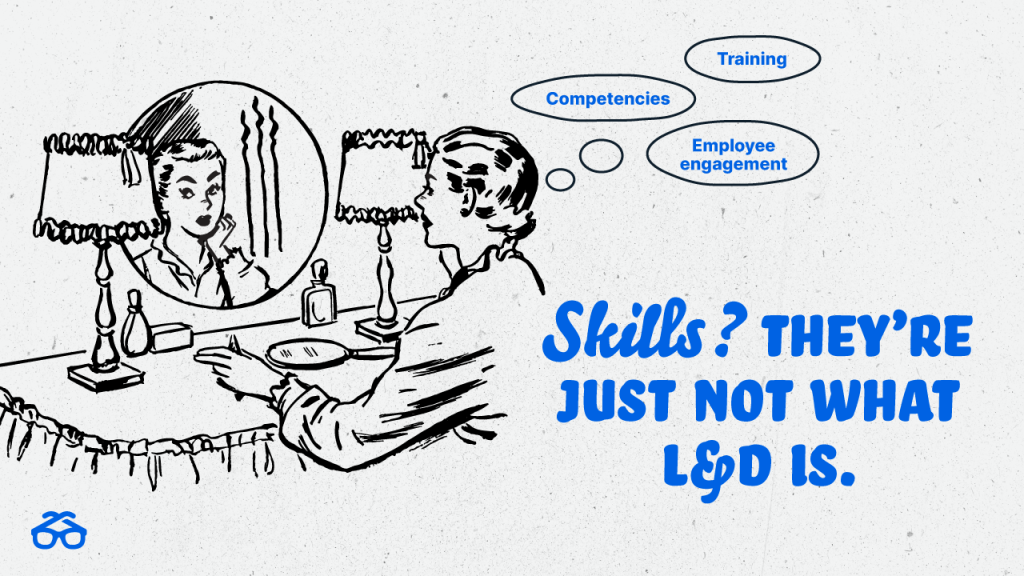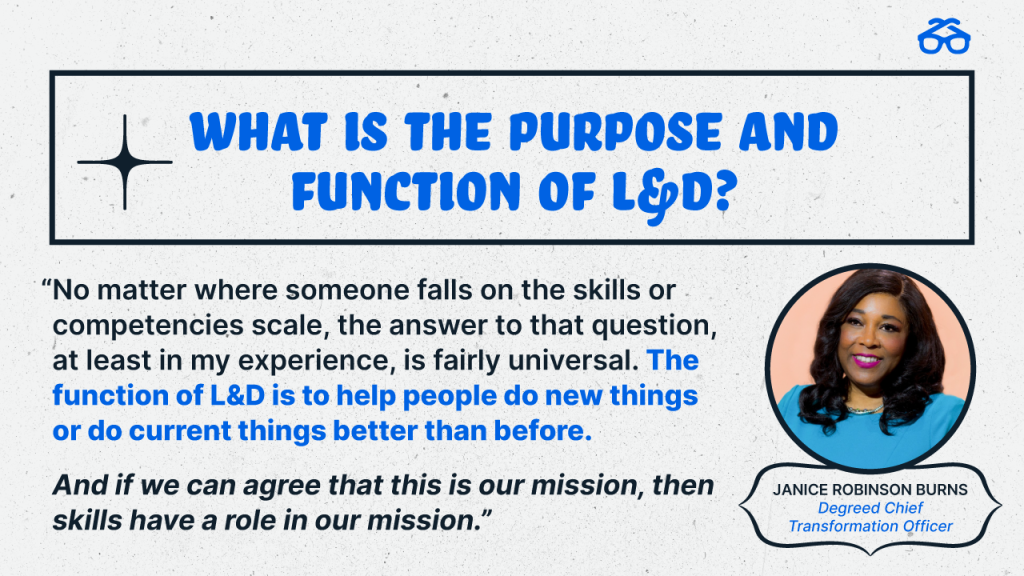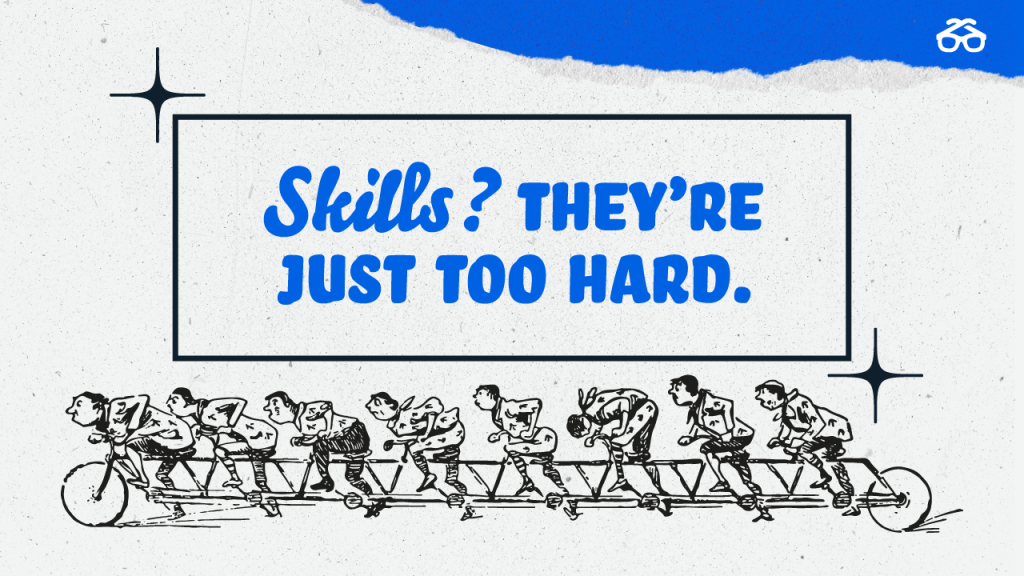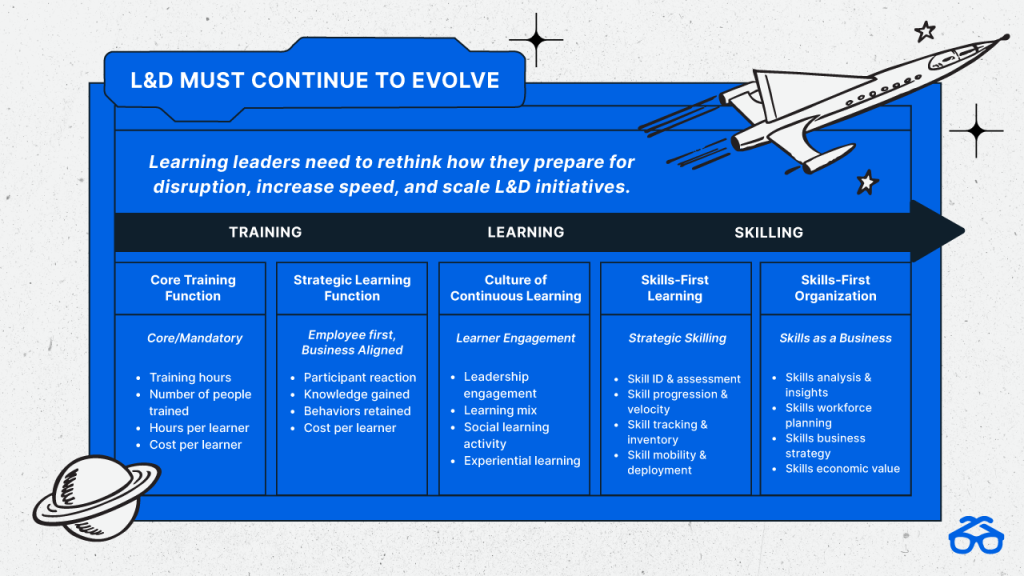Looking for an excuse to bypass the skill development bandwagon?
Perfect—you’re exactly who I wanted to talk to.
I want to chat with the fairly large population of L&D pros out there who either shy away from or tune out skills. I get it. Skills is sucking up a lot of oxygen in our profession right now. Colleagues, leadership, industry leaders, and even vendors pressure you to get on board.
I promise that the purpose of this article isn’t to convert you to join a skills-based organization (SBO) club. But while you don’t need to hitch a ride on the fast-paced, all-or-nothing express, it will help if you and your L&D team take at least a few steps down the skills path.
Let’s take a look at the most common reasons L&D professionals either ignore or delay progress on skills. After that, I’ll offer advice so it’s easier for you and your team to start taking small steps toward skill development.

No 1. “Skills? They’re not our responsibility.”
A lot of skills wallflowers are holding back out there. When skill development discussions ignite, some may fade into the background. It’s a comfortable position to take. In many companies, talent management and L&D teams are often organized under the HR, Talent, or another department.
If your company assigns talent and career development to other departments outside L&D, it’s natural for you to focus on the more tried and true elements of the job like learning engagement, learning culture, or cohort-based learning. It’s easy to think you can relax because someone else has “skills” covered.
But this thinking will become increasingly problematic. Holding on to divisions between HR, Talent, L&D, and other departments runs the risk of skills falling into a corporate no-man’s land. Corporate skill strategies often fail because there is confusion about who owns skills and or agreeing on a definition.

L&D pros can’t afford to be skills wallflowers.
L&D professionals, you may feel comfortable with how your company has organized learning, talent acquisition, and career development positions. However, these old divisions of labor responsibilities do not address rapidly growing skills gaps. The truth is that no department can afford to be a skills wallflower any longer.
A skills initiative is too big of a challenge and project for one or two departments to own. Skills is a vertical, horizontal, top-down, and bottom-up initiative. It’s all-inclusive. And it certainly calls for responsibility and ownership from a department that helps employees learn and develop.

No 2. “Skills? They’re not in our DNA.”
Another common reason to wave the skill development bandwagon on by is ontological. Many learning pros believe L&D exists to champion competencies—not skills. This is understandable because the building blocks for Talent and L&D has been competencies.
Over the past few decades, L&D professionals were trained to use competency models, and these models have grown strong roots in organizations. We’ve been trained to develop competencies: the complex mixtures of behaviors, abilities, knowledge, and skills that are tied to specific job roles.
Why would we abandon the competency model we know and love for a skills model that may end the role of jobs? From this perspective, skills aren’t just different but almost antithetical to rock solid L&D structures.
But here’s the thing: defining learning and development solely with competencies is problematic.
- First, competency models are complex and include some components—like abilities and attributes—that we can’t change.
- Second, many employees don’t see the full picture with competencies. Employees don’t see how developing competencies can help advance their careers—especially in the context of hiring managers consulting competencies to gauge whether someone has the skills and experience needed to do a job.
- Third, competency models are usually associated with job roles, not work like projects, tasks, assignments, or problems to be solved. What L&D does is ultimately not limited to a certain model. Nor should it be. Instead, if you focus on the overall mission of L&D, you’ll find there’s plenty of room for competencies and skill development.
Focus on the overall mission of L&D—not competencies.
I know we’re comfortable with competencies, but we must see the bigger picture. This brings me to an important question: What is the purpose and function of L&D?
No matter where someone falls on the skills or competencies scale, the answer to that question, at least in my experience, is fairly universal. The function of L&D is to help people do new things or do current things better than before.
And if we can agree that this is our mission, then skills have a role in our mission. Skills are defined as learning that can be applied. Skills are learned and developed—they’re what we do. We can’t help people do new things without skills entering the equation.

No 3. “Skills? They’re too hard to switch to.”
You might not have anything against skill development, but you still might not feel ready to jump on the bandwagon. The vehicle is moving fast, and getting yourself on board seems to require some expert stunt double maneuvers. You’ve got to move from your solid competencies platform and leap onto the fast-paced skills train.
To start making the move from what they know—competencies—to where they need to get—skills—lots of professionals define and compare the two models. They assume that if they compare the two long enough, they’ll find the magic key to get from here to there. But this definitional approach isn’t the answer.

Stop fixating on skills vs. competencies.
We’ve all seen the hype around skills vs. competencies. I’ve seen it in LinkedIn posts and comments, on webinars, at conferences, and during client discussions. Avoid getting sucked into it. While it may seem like a way to make the transition easier, it just psyches you out and makes something simple appear hard.
You don’t need a complex way to translate competencies into skills. Why? Because the skills are already there. Competencies are made up of skills. You just need to identify the skills in the competencies you’ve worked on for decades.
Once you identify the skills that make up competencies, focus on how you can better help employees to develop and practice them. Additionally, you may want to consider adding new ones. Skills change quickly, so keeping your eye on the skills needed to get work done is important.

No. 4 “Skills? They’re just too complex.”
Nothing scares L&D professionals off the skills path more than complexity. I’ll be honest with you: if you look at them holistically, skills are complex. From a numbers perspective alone, there are far more of them to track than competencies. Many companies that create a skills taxonomy have hundreds or even thousands of skills.
L&D pros are also scared by what they perceive as a steep learning curve. Many approach me holding a long laundry list of questions:
- How should we define skills?
- How do we get the whole company to agree on a single definition?
- How do you validate skills?
- What assessment model should we use?
- What technology platform is the best for capturing skill data?
And the list goes on and on. While questions in general are critical to learning and solving complex problems, you need to ask the right questions in the right order. This will vary from organization to organization, but let’s take a closer look.
You don’t need all the skills answers to get started.
Many L&D professionals believe they must know everything about skills before they can begin. While doing preliminary research is a tried-and-true strategy, the questions should enable you to act and not falter.
People always want to know the WHY in things before they change or adopt something new first. WIth this in mind, consider making your first step answering the why question.
Start with answering the WHY skills development question.
To better understand why, think about your company’s goals and plans. Show leaders how improving skills can help them reach these goals more quickly and efficiently. This discussion will help you determine what you need to do.
Perhaps leaders want to identify your company’s most critical skill gaps. Or perhaps they know which skills gap to tackle, and they need you to help them fill that gap. Ask questions about these specific action-focused items. Ask questions that lead to actions that will make a difference.

Skill Development—take it one step at a time.
While you may not realize it, you’re probably further down the skill development path than you think. Just look at the Learning Continuum grid above to see where you fall. If you see your organization as being anywhere on the continuum, guess what—you’ve already started your journey!
And keep in mind that you don’t have to jump on that fast-paced SBO bandwagon. You just need to start discussing skills and begin walking down the skill development path. For more help to start your skills journey, download a free copy of The Ultimate Guide to a Skills-First Future.

